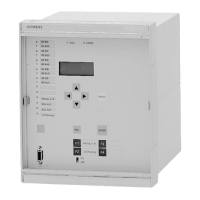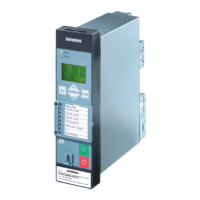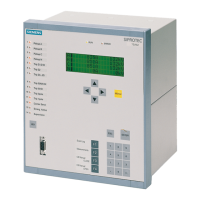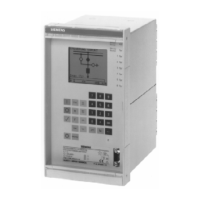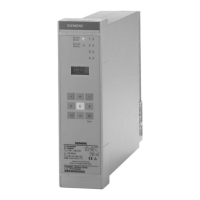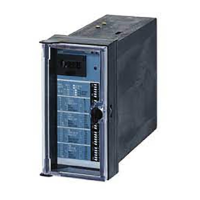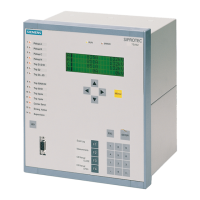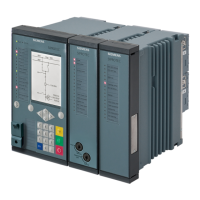Do you have a question about the Siemens SIPROTEC 7SK80 and is the answer not in the manual?
| Voltage Transformer Inputs | 4 |
|---|---|
| Binary Outputs | Up to 16 |
| Operating Temperature | -25 °C to +70 °C |
| Device Type | Protection Relay |
| Rated Auxiliary Voltage | 24 to 250 V DC, 100 to 230 V AC |
| Frequency | 50 Hz / 60 Hz |
| Current Input | 1 A or 5 A |
| Protection Functions | Overcurrent, Earth Fault |
| Communication Interfaces | Ethernet, RS485 |
| Communication Protocols | IEC 61850, Modbus TCP, DNP3 |
| Optional Communication | IEC 60870-5-103 |
| Mounting | panel mounting |
| Display | Graphical LCD |
| Power Supply | Via auxiliary voltage |
Describes the basic hardware structure and operational principles of the 7SK80 device.
Details the suitability of the SIPROTEC 4 7SK80 for various applications in asynchronous machines and networks.
Lists the general characteristics and specific features of the 7SK80 device, including protection functions.
Covers general settings, functional scope, and configuration procedures for the 7SK80 relay.
Explains definite and inverse time overcurrent protection elements for phase and ground currents.
Details directional ground overcurrent protection with definite and inverse time elements.
Describes how pickup and delay settings of time overcurrent protection can be dynamically changed.
Explains undervoltage and overvoltage protection functions, including selectable voltages and criteria.
Details definite and inverse time characteristics for detecting unbalanced loads and negative sequence currents.
Covers motor protection features like starting supervision, restart inhibit, and load jam detection.
Explains the function for detecting abnormally high and low frequencies in the system.
Describes thermal replica calculation and protection against thermal overloads.
Details comprehensive monitoring functions for hardware, software, and transformer circuits.
Explains ground fault detection methods, current elements, and tripping ranges.
Describes the function that monitors proper tripping of the circuit breaker.
Covers application of flexible protection principles and configuration options.
Details temperature measurement using RTD boxes and I/O 2 extension modules.
Explains implementation of phase rotation reversal using binary inputs and parameters.
Coordinates execution of protection and auxiliary functions, processing decisions and information.
Describes message processing, LEDs, binary outputs, and information transfer.
Details counting of trips, operating hours, and circuit breaker maintenance data.
Covers calculation and readout of minimum and maximum measured values.
Details metered values for active and reactive energy.
Provides tools for testing system interfaces, binary inputs/outputs, and creating oscillographic recordings.
Explains the integrated function for coordinating operation of circuit breakers and other equipment.
Highlights operational differences of the 7SK80 compared to other SIPROTEC 4 devices.
Provides general info, prerequisites, diagrams, and examples for device mounting and connections.
Details pin assignments for various interfaces and checks for system connections.
Covers test modes, system interface testing, configuring communication modules, and checking binary I/Os.
Outlines final steps for device preparation, including settings, clock, and LEDs.
Provides essential device data including analog inputs, auxiliary voltage, binary I/Os, communication interfaces, and electrical tests.
Details operating modes, measuring methods, setting ranges, times, dropout ratio, tolerances, and influencing variables.
Provides technical data for inverse time overcurrent protection, including trip time curves and tolerances.
Lists time overcurrent elements, direction determination methods, times, tolerances, and influencing variables.
Specifies controlled functions, setting ranges, functional limits, and cross-blocking for inrush restraint.
Details timed changeover of settings, setting ranges, and influencing variables.
Provides setting ranges, times, tolerances, and influencing variables for voltage protection.
Lists setting ranges, functional limits, times, dropout ratio, tolerances, and influencing variables.
Details setting ranges, trip curves, dropout ratio, tolerances, and influencing variables.
Provides setting ranges, restart threshold calculation, tolerances, and influencing variables.
Lists setting ranges, timers, dropout ratio, tolerances, and influencing variables.
Details setting ranges, times, dropout difference, dropout ratio, tolerances, and influencing variables.
Covers setting ranges, trip characteristic, dropout ratios, tolerances, and influencing variables.
Provides technical data for ground fault detection, including displacement voltage, current elements, and direction determination.
Details setting ranges, times, tolerances, and influencing variables for breaker failure protection.
Lists measured values, modes of operation, setting ranges, function limits, and tolerances.
Describes temperature sensors, measurement methods, and operational measured values.
Lists function modules, possible assignments to task levels, and general limits.
Provides technical data for operational measured values, energy metering, statistics, and min/max measurements.
Details the number of controlled switching devices, interlocking, messages, and command types.
Shows dimensional drawings for panel flush, cubicle, and panel surface mounting.
Lists ordering information for 7SK80 V4.6, accessories like interface modules, RTD boxes, and mounting rails.
Provides block diagrams showing terminal assignments for different 7SK80 housing types.
Illustrates various current and voltage transformer connection examples for different network configurations.
Details requirements for phase current transformers and accuracy limiting factors.
Summarizes default settings for LEDs, binary inputs, binary outputs, and function keys.
Compares functionality and transmission modes across different communication protocols.
Lists parameters and settings for enabling/disabling various functions and modes of operation.
Provides a comprehensive list of adjustable parameters for different functions with their addresses and default settings.
Lists all available indications, their functions, logging capabilities, and configuration matrix settings.
Organizes various fault and status messages into functional groups for easier analysis.
Lists operational measured values, their units, and conversion formulas.
